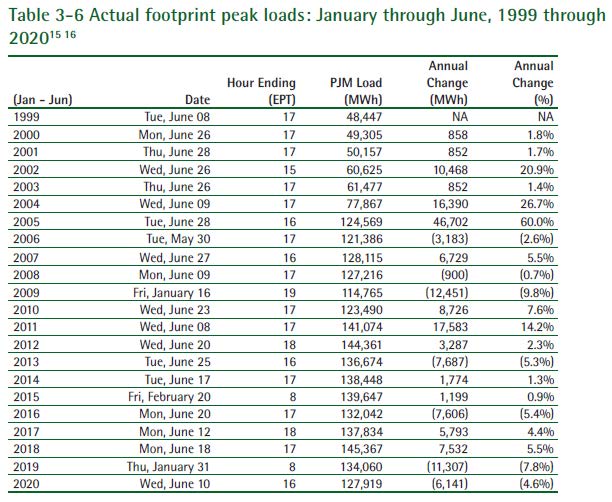2021 PJM State of Market Report
March 10th, 2022
Here it is:
PJM 2021 State of the Market Report
Note that where NERC does not project a significant decrease in coal production, PJM’s coal generation increased from 2020 to 2021 (now we do need to keep in mind that 2020 was a very low demand year):
Here’s an overall summary:
The big takeaway is that demand has increased over 2020, which is no surprise. Note the “Average Hourly Load” and “Average Hourly Generation” and compare with “Installed Capacity.” Capacity is essentially twice Average Hourly Load and Average Hourly generation (and note exports and imports are included).
And just for shits and giggles, here’s the PJM LOCATIONAL MARGINAL PRICING MAP!
And here’s MISO’s too:
MISO LMP Map
What it looks like right now in MISO:
PJM’s State of Market for 1st 1/2 of 2020
August 14th, 2020

PJM’s “independent” Monitoring Analytics (don’t know how independent it really is) has released its State of the Market report for the first two quarters of 2020, and there are some most interesting observations in this report. First, here’s the report:
The intro is astounding for the admissions about the electric market, decreased demand, and coal’s role:


That’s from page 2 of the PJM 2Q SoM Report.
Much of this new world is due to COVID, but the changes you see were in the works prior to COVID, which hit primarily starting 2nd Quarter. Demand has been lessening for a long time (the big increase circa 2003-2005 was when PJM territory expanded). Note that unlike MISO, it’s not strictly summer peaking, three peaks were in winter!

The histrionic squeals of “freezing in the dark on a respirator without a job” … or is it “in an incubator without a job,” either way, those fears did not materialize, and with the billions of dollars in transmission based on those hyped-up fears, where are we now? Another day older and deeper in debt…

And if you need wallpaper, do put up the LMP maps:
PJM: https://www.pjm.com/library/maps/lmp-map.aspx
MISO: https://api.misoenergy.org/MISORTWD/lmpcontourmap.html (something weird is going in MISO, the entire upper half is YELLOW!
Transmission? It’s NOT needed!!!
October 18th, 2012
Yes, once more with feeling… this transmission? It’s NOT needed!
Here’s an article from the St. Cloud Times, good to know they’re following up on the CapX 2020 transmission project and keeping an eye on Xcel Energy. This demonstrates what we’ve been saying for how long now? CapX 2020 is NOT needed:
Record hot summer didn’t mean record electricity useage, Xcel Energy reports
In fact, electricity use actually fell in the scorching summer of 2012.
PJM demand decrease 3.6%
April 16th, 2009
A quick post before heading off to the PUC for more CapX 2020…
A new little birdie sent some delightful PJM info, all about decreased demand, keep in mind, this is 2006-2007, and NOTE IT WAS ALREADY DROPPING THEN.
From FERC – Electric Power Markets PJM:
All time peak demand: 144,644 MW (set August 2, 2006)
Peak demand growth (2006-2007): Peak demand declined 3.6%
| 2006 | 2007 | |
|---|---|---|
| Summer Peak Demand (MW) | 144,644 | 139,438 |
| (Source: PJM) | ||
There, you’ll find PJM State of the Market, Vol. 1 & 2
PJM State of the Market Report Volume 1
Pg 12: “Aggregate supply increased by about 15 MH when comparing the summer of 2008 to 2007 while aggregate peak load decreased by 9,328 MW …”
Pg 22: ” In the Real Time Market in 2008 there were net exports at 16 of PJM’s 20 interfaces …”
Pg 31: “Imports & Exports Net exchange decreased 248.5 MW …..)
Pg 45 : ” Demand … It is not clear why the demand identified in the market solution is consistently less than the demand identified by the system operators.”
Pg 50: discussion on Congestion & its costs
PJM State of the Market, Vol. 1
PJM State of the Market, Vol. 2
adsfad




